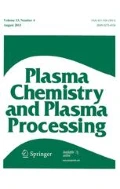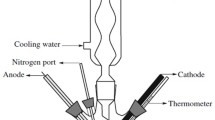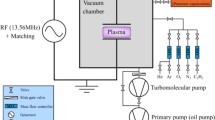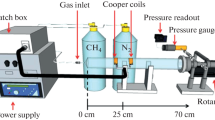Abstract
Controlling the concentration and nature of functional groups in plasma polymer films by adjusting the flow ratio of constituent precursor gases can be exploited to tune the surface charge of the resulting coating. Plasma polymer films containing various concentrations of nitrogen and oxygen functional groups were deposited in a low-pressure capacitively-coupled glow discharge reactor by plasma polymerization of binary gas mixtures of a hydrocarbon (ethylene or butadiene) and a heteroatom source gas (ammonia and/or carbon dioxide). Increasing the flow ratio of heteroatom to hydrocarbon gases increased the concentration of bonded nitrogen or oxygen, including that of primary amine or carboxylic groups as determined by X-ray photoelectron spectroscopy and chemical derivatization procedures. The zeta potential of samples was measured using an electro-kinetic analyser in a diluted sodium chloride solution. The deposition parameters controlled the composition of the coatings, allowing to tune the surface charge to either positive (ammonia based films)—or negatively (carbon dioxide base films) values at physiological pH.







Similar content being viewed by others
References
Lloyd AW, Faragher RG, Denyer SP (2001) Ocular biomaterials and implants. Biomaterials 22(8):769–785
Förch R, Chifen AN, Bousquet A, Khor HL, Jungblut M, Chu LQ, Zhang Z, Osey-Mensah I, Sinner EK, Knoll W (2007) Recent and expected roles of plasma-polymerized films for biomedical applications. Chem Vap Depos 13(6–7):280–294
Ponamoreva O, Kamanina O, Alferov V, Machulin A, Rogova T, Arlyapov V, Alferov S, Suzina N, Ivanova E (2014) Yeast-based self-organized hybrid bio-silica sol–gels for the design of biosensors. Biosens Bioelectron 67:321–326
Sriram M, Sainitya R, Kalyanaraman V, Dhivya S, Selvamurugan N (2015) Biomaterials mediated microRNA delivery for bone tissue engineering. Int J Biol Macromol 74:404–412
Wang X, Schröder HC, Müller WE (2014) Enzyme-based biosilica and biocalcite: biomaterials for the future in regenerative medicine. Trends Biotechnol 32(9):441–447
Yavari SA, Ahmadi S, Wauthle R, Pouran B, Schrooten J, Weinans H, Zadpoor A (2015) Relationship between unit cell type and porosity and the fatigue behavior of selective laser melted meta-biomaterials. J Mech Behav Biomed Mater 43:91–100
Zhao Y, Feric NT, Thavandiran N, Nunes SS, Radisic M (2014) The role of tissue engineering and biomaterials in cardiac regenerative medicine. Can J Cardiol 30(11):1307–1322
Chandra P, Yoo JJ, Lee SJ (2015) Biomaterials in regenerative medicine, challenges in technology transfer from science to process development. In: Atala A, Alickson J (eds) Translational regenerative medicine, 1st edn. Elsevier, Amsterdam
Gupta AK, Gupta M (2005) Synthesis and surface engineering of iron oxide nanoparticles for biomedical applications. Biomaterials 26(18):3995–4021
Bazaka O, Bazaka K (2015) Surface modification of biomaterials for biofilm control. In: Barnes L, Cooper IR (eds) Biomaterials and medical device—associated infections, 1st edn. Elsevier Woodhead, Amsterdam
Holmes C, Tabrizian M (2015) In Vishwakarma A, Sharpe P, Shi S, Ramalingam M, Stem cell biology and tissue engineering in dental sciences, Academic Press, London
Kurella A, Dahotre NB (2005) Review paper: surface modification for bioimplants: the role of laser surface engineering. J Biomater Appl 20(1):5–50
Bullett NA, Bullett DP, Truica-Marasescu F-E, Lerouge S, Mwale F, Wertheimer MR (2004) Polymer surface micropatterning by plasma and VUV-photochemical modification for controlled cell culture. Appl Surf Sci 235(4):395–405
Cireli A, Kutlu B, Mutlu M (2007) Surface modification of polyester and polyamide fabrics by low frequency plasma polymerization of acrylic acid. J Appl Polym Sci 104(4):2318–2322
Dhayal M, Jeong HG, Choi JS (2005) Use of plasma polymerisation process for fabrication of bio-MEMS for micro-fluidic devices. Appl Surf Sci 252(5):1710–1715
Garcia-Fernandez MJ, Martinez-Calvo L, Ruiz JC, Wertheimer MR, Concheiro A, Alvarez-Lorenzo C (2012) Loading and release of drugs from oxygen-rich plasma polymer coatings. Plasma Processes Polym 9(5):540–549
Alvarez-Lorenzo C, Bucio E, Burillo G, Concheiro A (2010) Medical devices modified at the surface by gamma-ray grafting for drug loading and delivery. Expert Opin Drug Deliv 7(2):173–185
Wang W, Wang L, Chen X, Yang Q, Sun TX, Zhou JF (2006) Study on the graft reaction of poly(propylene) fiber with acrylic acid. Macromol Mater Eng 291(2):173–180
Webb K, Hlady V, Tresco PA (1998) Relative importance of surface wettability and charged functional groups on NIH 3T3 fibroblast attachment, spreading, and cytoskeletal organization. J Biomed Mater Res 41(3):422–430
Vladkova TG (2010) Surface engineered polymeric biomaterials with improved biocontact properties. Int J Polym Sci. doi:10.1155/2010/296094
Meyer-Plath AA, Schröder K, Finke B, Ohl A (2003) Current trends in biomaterial surface functionalization—nitrogen-containing plasma assisted processes with enhanced selectivity. Vacuum 71(3):391–406
Siow KS, Britcher L, Kumar S, Griesser HJ (2006) Plasma methods for the generation of chemically reactive surfaces for biomolecule immobilization and cell colonization—a review. Plasma Process Polym 3(6–7):392–418
Girard-Lauriault P-L, Mwale F, Iordanova M, Demers C, Desjardins P, Wertheimer MR (2005) Atmospheric pressure deposition of micropatterned nitrogen-rich plasma-polymer films for tissue engineering. Plasma Process Polym 2(3):263–270
Oran U, Swaraj S, Lippitz A, Unger WES (2006) Surface analysis of plasma deposited polymer films, 7. Plasma Process Polym 3(3):288–298
Friedrich J, Kühn G, Mix R, Unger W (2004) Formation of plasma polymer layers with functional groups of different type and density at polymer surfaces and their interaction with Al atoms. Plasma Process Polym 1(1):28–50
Swaraj S, Oran U, Lippitz A, Friedrich JF, Unger WES (2005) Study of influence of external plasma parameters on plasma polymerised films prepared from organic molecules (acrylic acid, allyl alcohol, allyl amine) using XPS and NEXAFS. Surf Coat Technol 200:494–497 (1-4 SPEC. ISS.)
Wertheimer MR, St-Georges-Robillard A, Lerouge S, Mwale F, Elkin B, Oehr C, Wirges W, Gerhard R (2012) Amine-rich organic thin films for cell culture: possible electrostatic effects in cell–surface interactions. Jpn J Appl Phys 51(11S):11PJ04
Duque L, Queralto N, Francesch L, Bumbu GG, Borros S, Berger R, Forch R (2010) Reactions of plasma-polymerised pentafluorophenyl methacrylate with simple amines. Plasma Process Polym 7(11):915–925
Duque L, Menges B, Borros S, Forch R (2010) Immobilization of biomolecules to plasma polymerized pentafluorophenyl methacrylate. Biomacromolecules 11(10):2818–2823
Yasuda H (2012) Plasma polymerization. Academic press, Orlando
Dargahi M, Nelea V, Mousa A, Omanovic S, Kaartinen MT (2014) Electrochemical modulation of plasma fibronectin surface conformation enables filament formation and control of endothelial cell–surface interactions. RSC Adv 4(88):47769–47780
Dargahi M, Omanovic S (2014) A comparative PM-IRRAS and ellipsometry study of the adsorptive behaviour of bovine serum albumin on a gold surface. Colloids Surf B 116:383–388
Contreras-Garcia A, Wertheimer MR (2013) Low-pressure plasma polymerization of acetylene-ammonia mixtures for biomedical applications. Plasma Chem Plasma Process 33(1):147–163
Wertheimer MR, St-Georges-Robillard A, Lerouge S, Mwale F, Elkin B, Oehr C, Wirges W, Gerhard R (2012) Fabrication and characterization of organic thin films for applications in tissue engineering: emphasis on cell-surface interactions. In: Materials research society symposium proceedings, pp. 43–48
Ruiz JC, Girard-Lauriault PL, Poulin S, Truica-Marasescu F, Wertheimer MR (2009) Plasma and vacuum-ultraviolet (VUV) photo polymerisation of “mono-functional” thin films. In: 8th World congress of chemical engineering: incorporating the 59th Canadian chemical engineering conference and the 24th interamerican congress of chemical engineering
Girard-Lauriault PL, Truica-Marasescu F, Petit A, Wang HT, Desjardins P, Antoniou J, Mwale F, Wertheimer MR (2009) Adhesion of human U937 monocytes to nitrogen-rich organic thin films: novel insights into the mechanism of cellular adhesion. Macromol Biosci 9(9):911–921
Klages CP, Khosravi Z, Hinze A (2013) some remarks on chemical derivatization of polymer surfaces after exposure to nitrogen-containing plasmas. Plasma Process Polym 10(4):307–312
Truica-Marasescu F, Wertheimer MR (2008) Nitrogen-rich plasma-polymer films for biomedical applications. Plasma Process Polym 5(1):44–57
Hegemann D, Hossain M-M (2005) Influence of non-polymerizable gases added during plasma polymerization. Plasma Process Polym 2(7):554–562. doi:10.1002/ppap.200500041
Hossain MM, Herrmann AS, Hegemann D (2007) Incorporation of accessible functionalities in nanoscaled coatings on textiles characterized by coloration. Plasma Process Polym 4(2):135–144
Hammer P, Alvarez F (2001) Influence of chemical sputtering on the composition and bonding structure of carbon nitride films. Thin Solid Films 398:116–123
Hossain MM, Müssig J, Herrmann AS, Hegemann D (2009) Ammonia/acetylene plasma deposition: an alternative approach to the dyeing of poly(ethylene terephthalate) fabrics at low temperatures. J Appl Polym Sci 111(5):2545–2552
Hegemann D, Körner E, Albrecht K, Schütz U, Guimond S (2010) Growth mechanism of oxygen-containing functional plasma polymers. Plasma Processes Polym 7(11):889–898
Chan C-M, Ko T-M, Hiraoka H (1996) Polymer surface modification by plasmas and photons. Surf Sci Rep 24(1):1–54
Hossain MM, Hegemann D, Fortunato G, Herrmann AS, Heuberger M (2007) Plasma deposition of permanent superhydrophilic a—C:H: N films on textiles. Plasma Process Polym 4(4):471–481
Biederman H (2004) Plasma polymer films. Imperial College Press, London
Ruiz J-C, St-Georges-Robillard A, Thérésy C, Lerouge S, Wertheimer MR (2010) Fabrication and characterisation of amine-rich organic thin films: focus on stability. Plasma Process Polym 7(9–10):737–753
Shard AG, Whittle JD, Beck AJ, Brookes PN, Bullett NA, Talib RA, Mistry A, Barton D, McArthur SL (2004) A NEXAFS examination of unsaturation in plasma polymers of allylamine and propylamine. J Phys Chem B 108(33):12472–12480
Gengenbach TR, Griesser HJ (1999) Aging of 1, 3-diaminopropane plasma-deposited polymer films: mechanisms and reaction pathways. J Polym Sci Part A Polym Chem 37(13):2191–2206
Walker SL, Bhattacharjee S, Hoek EMV, Elimelech M (2002) A novel asymmetric clamping cell for measuring streaming potential of flat surfaces. Langmuir 18(6):2193–2198
Childress AE, Elimelech M (1996) Effect of solution chemistry on the surface charge of polymeric reverse osmosis and nanofiltration membranes. J Membr Sci 119(2):253–268
Author information
Authors and Affiliations
Corresponding author
Rights and permissions
About this article
Cite this article
Babaei, S., Girard-Lauriault, PL. Tuning the Surface Properties of Oxygen-Rich and Nitrogen-Rich Plasma Polymers: Functional Groups and Surface Charge. Plasma Chem Plasma Process 36, 651–666 (2016). https://doi.org/10.1007/s11090-015-9682-1
Received:
Accepted:
Published:
Issue Date:
DOI: https://doi.org/10.1007/s11090-015-9682-1




